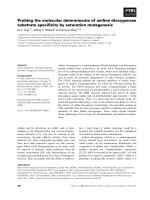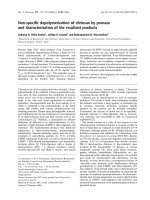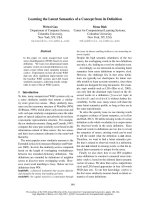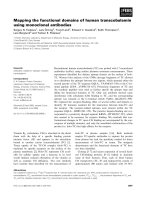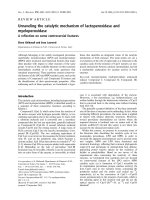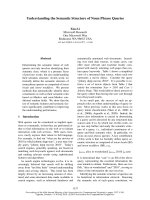báo cáo khoa học: " Assessing the spatial distribution of methadone clinic clients and their access to treatment" ppsx
Bạn đang xem bản rút gọn của tài liệu. Xem và tải ngay bản đầy đủ của tài liệu tại đây (6.12 MB, 6 trang )
Wong et al. Harm Reduction Journal 2010, 7:14
/>Open Access
BRIEF REPORT
© 2010 Wong et al; licensee BioMed Central Ltd. This is an Open Access article distributed under the terms of the Creative Commons
Attribution License ( which permits unrestricted use, distribution, and reproduction in
any medium, provided the original work is properly cited.
Brief report
Assessing the spatial distribution of methadone
clinic clients and their access to treatment
Ngai Sze Wong
1
, Shui Shan Lee*
1
and Hui Lin
2
Abstract
Using Geographic Information System (GIS), the spatial distribution of methadone clinic clients and their utilization of a
treatment service in Hong Kong was analysed. A majority (93.7%) of the 63 methadone users recruited were residing in
the same district, of which 84.1% spent not more than 15 minutes for traveling. Walking (55.6%) was the commonest
transport mode followed by cycling (30.2%). There was no distance decay effect on traveling time, but an association
between distance and transport selection could be demonstrated. The residence locations displayed a compact
distribution, merging with the general population without any evidence of clustering. Though the distribution of
methadone users could have been shaped by the location of clinic, it can also be concluded that methadone clinics at
convenient locations are needed if maintenance is a key determinant of service effectiveness.
Findings
Methadone utilization studies have so far been largely
conducted on individuals with a cross-sectional approach
[1], using national database [2] or through street inter-
views [3,4]. Apparently, there are knowledge gaps in
methadone users' transport selection, association of resi-
dence location with distance from clinic, and possible
spatial matching between users and the general popula-
tion. This study aims at determining the spatial pattern of
and the spatial influence on methadone treatment utiliza-
tion in Hong Kong. Located in South Eastern China,
Hong Kong has a population of about 7 million, a major-
ity of which Chinese. There are 20 methadone clinics dis-
tributing over 16 out of 18 administrative districts,(figure
1) serving more than 95% of heroin users in the territory
[5]. Methadone clients were approached by trained inter-
viewers in the vicinity of a clinic located in Tai Po District
(figure 1) during its opening hours. Over a one-month
period in October 2007, a total of 63 (out of 192 regis-
tered) methadone users were interviewed. Questions
about utilization included the frequency of visits per
week and one's readmission status. Spatial factors
included home location, transport mode, total traveling
time and transport fare from home to clinic, and resi-
dence location. As most methadone users were unwilling
to provide specific home address, a relative location esti-
mation method was adopted to supplement the informa-
tion. Respondents were inquired about location of the
nearest convenience store. Buffer was drawn to indicate
the most probable location. Estimation was then made by
generating random sampling points within the building
blocks inside the overlapped buffer areas. Personal fac-
tors including gender, age group (<20, 21-40, 41-60 and
>60), ethnicity and total number of years on methadone
treatment were recorded. GIS software (ArcGIS 9.2) was
used for data processing, visualization, and spatial statis-
tical analysis.
Of the methadone users recruited, 39.7% were aged 20-
41, 41.3% between 41 and 60, and 19% above 60. The
male-to-female ratio (1:0.17) was similar to that of the
clinic registrants. In accordance with the clinic's regula-
tion, defaulting treatment for over 28 days requires one to
go through a re-registration process, which is defined as
"re-admission" in the study. Some 34% of the respondents
had not been previously readmitted and had been visiting
the clinic every day. This latter sub-group of heroin users
was defined as having consistently utilized methadone
treatment for maintenance purpose. Geographically,
93.7% of the respondents were living in the district of Tai
Po where the clinic is located. Only 3 (4.8%) lived in an
adjacent district (North District) and another one further
away in Kwun Tong District (figure 1). A couple living in
North District went to the clinic every day, explaining
that Tai Po clinic was quieter with fewer drug users gath-
* Correspondence:
1
Stanley Ho Centre for Emerging Infectious Diseases, The Chinese University of
Hong Kong, Prince of Wales Hospital, Shatin, Hong Kong
Full list of author information is available at the end of the article
Wong et al. Harm Reduction Journal 2010, 7:14
/>Page 2 of 6
ering in its vicinity than the clinic in the district where
they resided. As most respondents were local residents, a
majority (61.9%) spent 10 minutes or less for going to the
clinic. Over 75% spent only 15 minutes for the trip by var-
ious transportation mode. The maximum amount of time
spent on travelling to the clinic was 60 minutes. Overall,
about half (55.6%) went to the clinic by walking and 30.2%
by cycling, so they did not need to pay for their daily trip.
A minority (14.3%) had to pay for the transportation.
Using one-way ANOVA, there was no significant gender
difference for the readmission status, F (1, 61) = 2.011, p >
0.05 and the frequency of clinic visits per week, F (1, 61) =
1.898, p > 0.05. Age was not significantly associated with
the frequency of clinic visits per week, F (2, 60) = 0.327, p
> 0.05. Comparison was made between clients consis-
tently utilizing methadone treatment and otherwise, as
defined by daily clinic attendance and absence of read-
mission. There was no significant difference between the
two.
Figure 2 shows the spatial distribution of the residence
location of respondents living in Tai Po by the relative
location estimation method. Figure 3 shows the location
of the spatial mean centre [6] for each transportation
mode. The mean centre of residence location of respon-
dents choosing the walking mode was closer to the clinic
than those coming by cycling. Public transport mode
(including bus and mini-bus) gave a mean centre further
away from the clinic. Efficiency of walking was reduced
by distance friction. Those living farther away were
inclined to use more efficient transport mode, such as
cycling, to access the clinic. The distribution of Tai Po
District's residents was reflected by the mean centre and
standard distance of the residential buildings of the dis-
trict. As illustrated in figure 4, the spatial mean centre of
the residence location of respondents living in the district
was very close to that of the residential buildings. The
methadone clinic was within the buffer zone representing
67% (1 Standard Deviation/S.D.) of the spatial dispersion
of local respondents' residence locations. To illustrate the
compactness of the distribution, almost all (99.73% or 3
S.D.) local respondents were living in a zone overlapping
that of the standard distance (1 S.D.) of residential build-
Figure 1 Map of Hong Kong showing boundaries of 18 administrative districts, location of 20 methadone clinics including the study clinic
and the district where the clinic is located.
Wong et al. Harm Reduction Journal 2010, 7:14
/>Page 3 of 6
ings in the district. In fact none of the local respondents
was living beyond the zone covering 1 S.D. of Tai Po resi-
dential buildings.
To our knowledge, this is the first spatial study on
methadone treatment utilization using GIS applications.
The study has enabled us to explore the social and public
health contexts of heroin dependence from two inter-
relating angles: distribution of methadone clients on one
hand, and the utilization of clinic services on the other, as
exemplified by the situation in Hong Kong. In interpret-
ing the results in the study, there are two unique features
of heroin dependence in Hong Kong which need to be
viewed in perspective. First of all, while heroin has con-
tinued to be the most important drug of dependence
locally, the number of new heroin users has been falling
steadily over the years. This is reflected in the statistics of
the Central Registry of Drug Abuse, which shows the
reported number of new cases falling from 1075 in 2000
to 707 in 2006 [7]. The overall median age of heroin users
was high at 41, suggesting that a majority had taken on
the habit for years, thus contributing to a high prevalence
whereas the incidence has been on the decline. Similar
pattern may not be seen in other countries, and the possi-
ble impacts on observations made in this study should be
interpreted with caution. Secondly, methadone clinics
have been in operation in Hong Kong for much longer
than their equivalents in neighboring countries. Todate,
HIV prevalence has remained low in seroprevalence
studies in Hong Kong [8]. Whereas methadone clinics
were recently established in response to the rising HIV
threats in many Asian countries, the services have been
established in Hong Kong before HIV/AIDS was discov-
ered, back in the early 1970s.
Overall, our study suggested a very compact distribu-
tion of methadone clients in a district in Hong Kong. The
proximity of the mean centre of the respondents' resi-
Figure 2 Transport modes and traveling time of methadone clients, showing resident locations of respondents who attended the clinic on
foot, by cycling or vehicle transport, the latter referring to bus, train, taxi and driving (1 patient), and excluding 4 living outside Tai Po Dis-
trict.
Wong et al. Harm Reduction Journal 2010, 7:14
/>Page 4 of 6
dence locations and that of the district's residential build-
ings suggested that methadone clients were integrated
with the local population. Their location near the Dis-
trict's methadone clinic indicated that they were rela-
tively immobile. This can be explained by the older age of
the methadone clients, many of which could have retired
and therefore not as active as the younger counterparts.
With a median age of 41 in reported heroin users [7], it is
possible that the same phenomenon prevailed in other
districts in the territory. From another perspective, the
distribution of heroin users in Hong Kong might have
been influenced by the setting up of methadone clinics
about 30 years ago. It can be argued that in order to have
good access to methadone, some heroin users might have
migrated from their original areas of gathering to the new
neighbourhoods of methadone clinics. The compact dis-
tribution of heroin users may therefore not be a primary
feature of this marginalized community but rather a
response to methadone treatment programme. In our
study, the traveling time to methadone clinic did not vary
significantly with distance from a heroin user's residence
location (figure 2). Distance decay was not observed,
which could be due to one of 2 reasons: Firstly, all local
respondents were living within 1620 m from the clinic.
Thus, distance decay might not have started within this
range. Secondly, as shown in figure 3, methadone clients
living further away tended to use more efficient transport
mode to shorten their traveling time, indicating the possi-
ble presence of distance decay effect on transport selec-
tion rather than travelling time. The influence of distance
on transport mode matched with the findings of Field &
Briggs on the frequency of visits to GP's surgery in the
United Kingdom [9]. Patients living within 1 mile of the
facility were more likely to walk while the proportion of
those driving to the clinic increased with distance. Our
observation carries important implications in the design
Figure 3 Mean centres for transport modes of methadone treatment users interviewed in the study.
Wong et al. Harm Reduction Journal 2010, 7:14
/>Page 5 of 6
of methadone treatment services. As utilization hinges on
the access and adherence of clients to methadone, having
clinics at convenient locations is crucial for ensuring
effective maintenance, as has been concluded in other
studies [10].
Competing interests
The authors declare that they have no competing interests.
Authors' contributions
NSW conducted field study, collated the data, generated the maps, conducted
all statistical analyses, and prepared the first draft of the manuscript. HL pro-
vided technical advice on the study design. SSL conceptualized the study,
coordinated the research and edited the manuscript. All read the revised ver-
sion of the manuscript and approved the final version.
Acknowledgements
Special thank to Ms. Tak Ting Pang for her contribution of ideas in the study
and Mr. Siu Chuen Cheung for his assistance in interviewing methadone cli-
ents. The authors thank all respondents for their participation in the study,
social workers and outreach workers of the methadone clinic for their support
and advice.
Author Details
1
Stanley Ho Centre for Emerging Infectious Diseases, The Chinese University of
Hong Kong, Prince of Wales Hospital, Shatin, Hong Kong and
2
Institute of
Space and Earth Information Science, The Chinese University of Hong Kong,
Shatin, Hong Kong
References
1. Schutz CG, Rapiti E, Vlahov D, Anthony JC: Suspected determinants of
enrollment into detoxification and methadone maintenance
treatment among injecting drug users. Drug Alcohol Depend 1994,
36(2):129-138.
2. Hser Y-I, Maglione M, Polinsky ML, Anglin MD: Predicting drug treatment
entry among treatment-seeking individuals. J Subst Abuse Treat 1998,
15(3):213-220.
3. Weatherburn D, Lind B: Street-level drug law enforcement and entry
into methadone maintenance treatment. Addiction 2001, 56:577-587.
4. Corsi KF, Kwiatkowski CF, Booth RE: Treatment entry and predictors
among opiate-using injection drug users. Am J Drug Alcohol Abuser
2007, 33:121-127.
5. Lee SS: A humble service that has delivered public health good. Public
Health 2007, 121(11):884-886.
Received: 12 February 2009 Accepted: 5 July 2010
Published: 5 July 2010
This article is available from: 2010 Wong et al; licensee BioMed Central Ltd. This is an Open Access article distributed under the terms of the Creative Commons Attribution License ( .0), which permits unrestricted use, distribution, and reproduction in any medium, provided the original work is properly cited.Harm Reduction Journal 2010, 7:14
Figure 4 Comparison of mean centre and standard deviation of residential buildings of Tai Po District and the residence locations of meth-
adone treatment users in the survey.
Wong et al. Harm Reduction Journal 2010, 7:14
/>Page 6 of 6
6. Fotheringham AS, Brunsdon C, Charlton M: Quantitative Geography:
Perspectives on Spatial Data Analysis. London: SAGE Publications; 2000.
7. Narcotics Division: Central Registry of Drug Abuse 56
th
Report. 2007
[ Hong Kong: Hong Kong
Special Administrative Region Government
8. Chan MKT, Lee SS: Can the low HIV prevalence in Hong Kong be
maintained? AIDS Educ Prev 2004, 16(Supp A):18-26.
9. Field KS, Briggs DJ: Socio-economic and locational determinants of
accessibility and utilization of primary health-care. Health & Social Care
in the Community 2001, 9(5):294-308.
10. Borisova NN, Goodman AC: The effects of time and money prices on
treatment attendance for methadone maintenance clients. J Subst
Abuse Treat 2004, 26(1):345-52.
doi: 10.1186/1477-7517-7-14
Cite this article as: Wong et al., Assessing the spatial distribution of metha-
done clinic clients and their access to treatment Harm Reduction Journal
2010, 7:14

